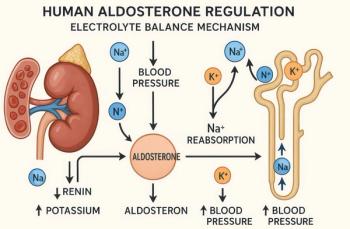
Hyperkalemia: ECG Findings
A 27-year-old woman with hypertension, type 1 diabetes mellitus, and end-stage renal disease presents to an outpatient renal clinic complaining of generalized weakness. She missed her last dialysis session 2 days earlier.
A 27-year-old woman with hypertension, type 1 diabetes mellitus, and end-stage renal disease presents to an outpatient renal clinic complaining of generalized weakness. She missed her last dialysis session 2 days earlier.
She appears alert when stimulated but is otherwise lethargic. Heart rate is 70 beats per minute; respiration rate, 28 breaths per minute; blood pressure, 100/70 mm Hg; and oxygen saturation, 93% on room air. Bibasilar rales are audible on auscultation.
Laboratory studies, a chest radiograph, and a 12-lead ECG are ordered. The rhythm strip and the 12-lead ECG are shown here.
What diagnosis do the ECG findings suggest?(Answer and discussion begin on next page.)
Answer: Hyperkalemia
WHAT THE ECG SHOWS
The ECG rhythm strip (Figure 1) shows a wide, regular QRS-complex rhythm with a sine-wave configuration and the absence of discern-ible P waves. The 12-lead ECG (Figure 2) shows similar findings: markedly widened QRS complexes with a sine-wave morphology and undiscernible P waves. The findings on both the rhythm strip and the 12-lead ECG are consistent with the sinoventricular rhythm that is a hallmark of severe hyperkalemia.
ECG MANIFESTATIONS OF HYPERKALEMIA Elevated serum potassium levels lead to a disruption of cardiac electrical conduction. Increasingly high values are associated with a greater potential for ECG abnormality and dysrhythmia. The ECG manifestations associated with hyperkalemia include:
• Prominent T waves.
• PR-interval prolongation.
• Loss of the P wave.
• QRS-complex widening.
• The sinusoidal QRS-complex configuration (loss of the P wave associated with the sine-wave QRS complex, which is termed the "sinoventricular rhythm").
Significant variation is found among patients at any particular serum potassium level; in general, more slowly developing hyperkalemia tends to produce fewer ECG manifestations at any serum level, while sudden increases in the potassium concentration are likely to cause significant ECG abnormalities even at lower levels. Moreover, the ECG may not show classic abnormalities in all patients1-4; in fact, the ECG may appear normal or nonspecifically abnormal-or may display an unusual abnormality, such as a heart block or bundle-branch block, rather than the findings described above.
Modest increases in the serum potassium level enhance or accentuate repolarization of the myocyte, which is manifested electrocardiographically by alterations in the appearance of the T wave (Figures 1, 2, 3, and 4).1 The prominent T wave is considered the first ECG manifestation of hyperkalemia.1 This prominent T wave is described as tall and narrow with a symmetric structure (see Figures 3 and 4A). The polarity of the T wave may also change, particularly in patients with left ventricular hypertrophy, in whom the normally inverted lateral T waves become upright or "pseudonormalized."3
A further increase in the serum potassium level slows or prolongs cardiac conduction. All cardiac myocytes are sensitive to elevated potassium levels; atrial tissue, however, is significantly more sensitive than other cardiac tissues to the effects of hyperkalemia. Thus, PR-interval prolongation occurs first, followed by a dampening of the P wave. At progressively higher serum levels, the QRS complex widens (see Figure 4B), at times resembling QRS complexes seen in bundle-branch blocks. Eventually, the QRS complex blends with the T wave, forming a "sine-wave," or sinusoidal structure on the ECG (see Figures 1, 2, and 4C). At this point, the P wave diminishes further in amplitude, and with continued elevation of the serum potassium level, ultimately disappears (see Figures 1 and 2). Despite the loss of the P wave, sinus node activity is maintained and sinus rhythm continues, resulting in the sinoventricular rhythm of hyperkalemia (see Figures 1 and 2).5 Further increases in the potassium level eventually result in ventricular fibrillation and asystole.3
MANAGEMENT OF HYPERKALEMIA
The management of hyperkale-mia is guided in large part by the patient's clinical findings, including the ECG findings. In fact, the ECG should guide both the urgency as well as the magnitude of therapy. The management of hyperkalemia has 3 primary goals:
• Stabilization of the myocardial cell membrane.
• Shift of the potassium from the vascular space to the intracellular space.
• Permanent removal of the potassium from the body.
An ability to recognize the ECG pattern seen in Figures 1 and 2-the sinoventricular rhythm of hyperkalemia-permits initiation of empiric therapy for this life-threatening condition before laboratory confirmation. Response to therapy is often prompt and is visualized on the ECG (Figure 5).
Stabilization of the cardiac cell membrane is the initial and most vital therapeutic goal. It is accomplished by the administration of calcium chloride or calcium gluconate (Table). Calcium restores a more appropriate electrical gradient across the cell membrane; in essence, it fools the cell into thinking that the electrical difference between the intracellular and extracellular compartments is more normal than is actually the case. Administration of calcium is most appropriate in patients with a widened QRS complex. Caution is advised when administering calcium in the setting of hyperkalemia related to digoxin toxicity; anecdotal reports suggest an enhanced tendency toward asystole in this clinical setting-although this association has never been proved.
Shifting of potassium from the vascular to the intracellular space. The deleterious effect of potassium on the myocyte can be temporarily lessened by shifting the electrolyte from the vascular to the intracellular space. Although the shift is transient, this aspect of the management strategy is highly important. Numerous medications are capable of transiently shifting potassium intracellularly. These include glucose, insulin, β-adrenergic agonists, magnesium, sodium bicarbonate, and intravenous saline. Because the potassium-lowering effect of these agents is transient, repeated administration is necessary if hemodialysis has not been initiated.
Glucose and insulin. These agents produce the potassium shift via stimulation of the cellular glucose pump. When administered as combination therapy, they lower the serum potassium level by about 1 mEq/L over 20 to 60 minutes, with the greatest reduction occurring in the first 20 minutes. Exercise caution when treating with glucose and insulin: hypoglycemia can develop.
β-Adrenergic agonists. Agents such as albuterol work via the cAMP-mediated potassium pump, resulting in a migration of potassium to the intracellular space. Albuterol lowers the serum potassium level by 0.5 to 1.0 mEq/L over 30 minutes. Albuterol is usually given most easily via a nebulizer at a standard metered dose. Other agents, such as intravenous epinephrine, have a similar effect but should only be used in the setting of cardiorespiratory arrest.
Magnesium. Intravenous magnesium works via stimulation of the sodium-potassium ATPase pump, in a manner similar to that of the β-agonists. Magnesium produces a rapid reduction in the serum potassium level, with an effect evident as early as 5 minutes after administration. The magnitude of the reduction in the potassium level is about 0.5 mEq/L per treatment.
Sodium bicarbonate. This agent also promotes a shift of potassium to the intracellular space. The magnitude of the potassium reduction achieved with this agent is best expressed as a function of the pH: for every 0.1 increase in serum pH, the serum potassium level falls by about 0.5 mEq/L. Sodium bicarbonate is most appropriate in patients with acidosis.
Complete and permanent removal of potassium from the body is accomplished via furosemide-hastened saline diuresis, binding resins, and hemodialysis. Binding resins, such as polystyrene, lower the serum potassium by 0.5 to 1.0 mEq/L per treatment. The lowering effect of polystyrene is slow in onset, requiring 60 to 120 minutes before it is seen. Hemodialysis is the treatment of choice for hyperkalemia and should be used in the vast majority of patients who present with a sine-wave QRS complex or who have experienced cardiac arrest related to hyperkalemia. Hemodialysis can remove up to 50 mEq of potassium per hour of therapy.
OUTCOME OF THIS CASE
The sinoventricular rhythm on the patient's ECG (see Figures 1 and 2) indicated severe hyperkalemia. She was immediately given various intravenous medications, including calcium chloride, regular insulin, 50% dextrose, and sodium bicarbonate; she also received nebulized albuterol and oral polystyrene binding resin. She was then transferred to the ICU, where arrangements for emergent hemodialysis were made. Results of laboratory studies revealed a serum potassium level of 8.1 mEq/L and metabolic acidosis; laboratory results also suggested acute renal failure.
Before the patient underwent hemodialysis, a second ECG was obtained, which showed a marked narrowing of the QRS complex and the development of very prominent T waves in the anterolateral leads (Figure 3 [compare with Figure 2]). During this time, the patient received insulin, 50% dextrose, sodium bicarbonate, and nebulized albuterol. She then underwent hemodialysis, which reduced her serum potassium level to 4.2 mEq/L. A third ECG (Figure 6), obtained 24 hours later, showed a normalization of the T-wave abnormalities seen in Figure 3. The hyperkalemia resulted from acute renal failure, which occured because the patient had missed a dialysis session.
References:
REFERENCES:
1. Martinez-Lopez JI. ECG of the month. Harbinger of evil. Hyperkalemia. J La State Med Soc. 1997;149:103-104.
2. Pick A. Arrhythmias and potassium in man. Am Heart J. 1966;72:295-306.
3. Martinez-Vea A, Bardaji A, Garcia C, et al. Severe hyperkalemia with minimal electrocardiographic manifestations: a report of seven cases. J Electrocardiol. 1999;32:45-49.
4. Yu AS. Atypical electrocardiographic changes in severe hyperkalemia. Am J Cardiol. 1996;77:906-908.
5. Dittrich KL, Walls RM. Hyperkalemia: ECG manifestations and clinical considerations. J Emerg Med. 1986;4:449-455.
Newsletter
Enhance your clinical practice with the Patient Care newsletter, offering the latest evidence-based guidelines, diagnostic insights, and treatment strategies for primary care physicians.


















































































































































































































































































